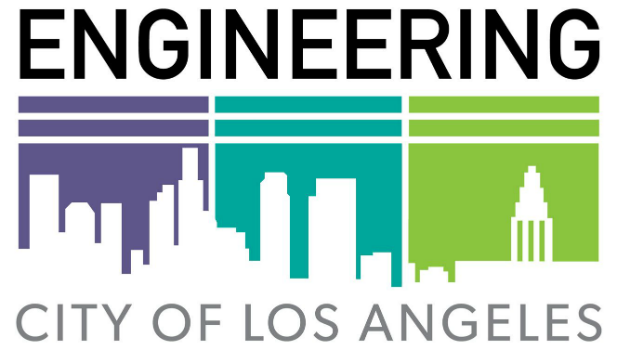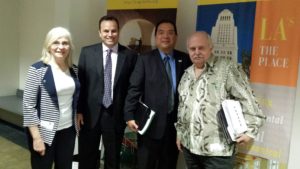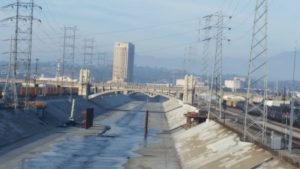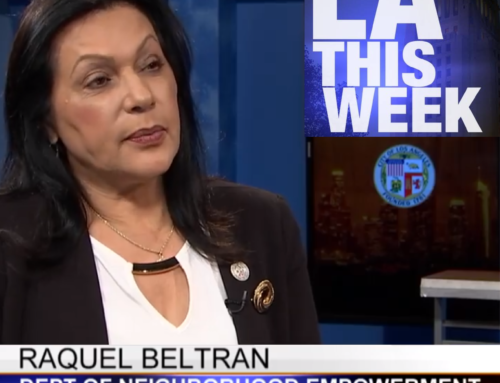Neighborhood Council Budget Advocates Meet with City of Los Angeles Bureau of Engineering Deputies
By Connie Acosta
On Tuesday, November 21, 2017, Neighborhood Council (NC) Budget Advocates, Barbara Ringuette, from Silver Lake NC, and Brian Allen, from Granada Hills NC, met with Engineering, Ted Allen, Deputy City Engineer; Mary Nemick, Director of Communications; and Robert Kadomatsu, Chief Management Analyst— to learn about what Engineering does, how it functions, and its annual budget needs.
The day was an exciting one at the Bureau of Engineering, as news had broken that the Elon Musk Boring Company had just submitted a permit application to the bureau for a pilot tunneling project under Los Angeles, which could offer an alternative to congested streets.
Ted Allen, in charge of the Development Services and Permits (DSP) program, reviewed the Bureau’s primary functions: (1) to deliver capital projects, (2) to permit infrastructure improvements in the public right-of-way including streets and sidewalks, and (3) to serve as map keeper archiving old street and bridge plans and reproducing maps including NavigateLA, a web-based application available at navigatela.lacity.org/
Robert Kadomatsu, in charge of finance and administrative services explained that the Bureau’s budget priorities are: (1) the Sidewalk and Complete Streets program, (2) the the DSP program, (3) the Mobility program, (4) the Mayor’s focus on housing for the homeless, (5) the Public Buildings and Open Spaces program and (6) the Wastewater program.
The Bureau designs, constructs and delivers the City’s capital projects including wastewater, municipal buildings, open spaces, recreation and park facilities as well as bridge and street improvements. For information on Engineering’s Programs, go to: <http://eng.lacity.org>.
Most of the Bureau’s work is completed by in-house staff but supplemented by consultants. There are two primary reasons for hiring contracted staff (1) “When we don’t have the in-house expertise to do some or all of a particular project,” said Allen, and (2) “for staff augmentation, when there’s not enough staff to deliver a particular project.” Hiring outside consultants avoids laying off Engineering staff, when there’s an economic downturn, while keeping the expertise with Engineering. “The specific projects that consultants are utilized for is generally left up to the Division Engineers that are closer to the projects and the available staffing” Allen said.
“Our services are to perform the design the construction management part of the project,” Allen said as Robert Kadomatsu added, “someone else goes to get the money and we complete the projects.” Other City Departments and Bureaus will purchase or reimburse the Bureau of Engineering for providing various engineering services.
For example, the owner/operator of the infrastructure project, such as the Department of Recreation and Parks for parks, or the Bureau of Sanitation for the sewer system, do the advanced planning and grant applications for their project. “They identify the funding and we deliver their project,” said Kadomatsu.
Wastewater is a fully Special funded Program and constitutes about half of Engineering’s workload and budget. The Sewer Capital Fund comes from Sanitation sewer charges collected by DWP and for fiscal year 2016-17 contributed $38,780,659 to the Bureau of Engineering’s $86, 492,282 budget.
Two major mechanisms that track projects and funds within the City are: (1) the Construction Projects Report (CPR), that provides status and funding information on various City capital projects going on in the city, and (2) the Financial Status Report (FSR) that updates the financial status of the City, its departments, highlights fiscal concerns, and identifies fund transfers, the movement of funding from one department or Fund to another, as well as funding appropriations. Among recent Capital Projects being developed by the Bureau are projects along the Los Angeles River, the Los Angeles Street Civic Building, and the Sixth Street Viaduct Replacement Project.
The Sixth Street Viaduct Replacement project is the largest project that the Bureau of Engineering currently has: a 3,500 feet long bridge with expanded bike and pedestrian lanes. Below the bridge, there are a number of railroad tracks running on both sides of the Los Angeles River, Allen explained, which makes the construction very complex. The “old bridge was torn down, because the aggregates used in 1928 started to create a chemical reaction with the cement, cracking the structure”, he said.
“It had what is known as an “Alkali Silica Reaction” or a “concrete cancer”. It was crumbling from the inside. We couldn’t even recycle the concrete,” Mary Nemick added. So the bridge had to come down for safety reasons. It went directly to a landfill except that two summers ago we held a Rock Day LA and gave 1,300 pieces of the bridge away, Nemick said.
Engineering is losing people to retirement. To recruit civil and structural engineers, the Bureau participates in career fairs at local universities, and in the last three years has started to recruit across the country Mr. Kadomatsu said. “It’s not easy finding the quantity of highly qualified people that we need to replace our retirees, but with our expanded recruitment efforts, we have been able to do so,” said Allen.
Connie Acosta is an independent reporter and board member of the Echo Park Neighborhood Council.








